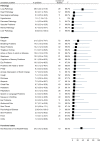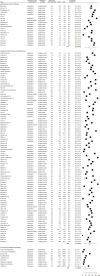Systematic Review of the Prevalence of Long COVID
- PMID: 37404951
- PMCID: PMC10316694
- DOI: 10.1093/ofid/ofad233
Systematic Review of the Prevalence of Long COVID
Abstract
Background: Long COVID occurs in those infected with severe acute respiratory syndrome coronavirus 2 (SARS-CoV-2) whose symptoms persist or develop beyond the acute phase. We conducted a systematic review to determine the prevalence of persistent symptoms, functional disability, or pathological changes in adults or children at least 12 weeks postinfection.
Methods: We searched key registers and databases from January 1, 2020 to November 2, 2021, limited to publications in English and studies with at least 100 participants. Studies in which all participants were critically ill were excluded. Long COVID was extracted as prevalence of at least 1 symptom or pathology, or prevalence of the most common symptom or pathology, at 12 weeks or later. Heterogeneity was quantified in absolute terms and as a proportion of total variation and explored across predefined subgroups (PROSPERO ID CRD42020218351).
Results: One hundred twenty studies in 130 publications were included. Length of follow-up varied between 12 weeks and 12 months. Few studies had low risk of bias. All complete and subgroup analyses except 1 had I2 ≥90%, with prevalence of persistent symptoms range of 0%-93% (pooled estimate [PE], 42.1%; 95% prediction interval [PI], 6.8% to 87.9%). Studies using routine healthcare records tended to report lower prevalence (PE, 13.6%; PI, 1.2% to 68%) of persistent symptoms/pathology than self-report (PE, 43.9%; PI, 8.2% to 87.2%). However, studies systematically investigating pathology in all participants at follow up tended to report the highest estimates of all 3 (PE, 51.7%; PI, 12.3% to 89.1%). Studies of hospitalized cases had generally higher estimates than community-based studies.
Conclusions: The way in which Long COVID is defined and measured affects prevalence estimation. Given the widespread nature of SARS-CoV-2 infection globally, the burden of chronic illness is likely to be substantial even using the most conservative estimates.
Keywords: Long COVID; SARS-CoV-2; prevalence; systematic review.
© The Author(s) 2023. Published by Oxford University Press on behalf of Infectious Diseases Society of America.
Conflict of interest statement
Potential conflicts of interest. DCG is a coinvestigator on the NIHR-funded LOCOMOTION study. NAA has lived experience of Long COVID, is a coinvestigator on the NIHR-funded STIMULATE-ICP and HI-COVE studies, has contributed in an advisory capacity to World Health Organization (WHO) and the European Union Commission's Expert Panel on effective ways of investing in health meetings in relation to post-COVID-19 condition, and has acted as a collaborator on some of the UK's Office for National Statistics outputs on the prevalence of Long COVID. AA has lived experience of Long COVID, is a co-founder of the Patient-Led Research Collaborative, and has contributed in an advisory capacity to National Institutes of Health, Centers for Disease Control and Prevention, and WHO. All authors: No reported conflicts of interest.
Figures





References
-
- World Health Organization . A clinical case definition of post COVID-19 condition by a Delphi consensus. Available at: https://www.who.int/publications/i/item/WHO-2019-nCoV-Post_COVID-19_cond.... Accessed 5 November 2022.
-
- National Institute for Health and Care Excellence (NICE) . COVID-19 rapid guideline: managing the long-term effects of COVID-19. Available at: https://www.nice.org.uk/guidance/NG188. Accessed 5 November 2022. - PubMed
-
- Centers for Disease Control and Prevention (CDC) . Post-COVID Conditions: Overview for Healthcare Providers. Available at: https://www.cdc.gov/coronavirus/2019-ncov/hcp/clinical-care/post-covid-c.... Accessed 5 November 2022.
LinkOut - more resources
Full Text Sources
Research Materials
Miscellaneous

